The Life and Ministry of St John the Baptist through Iconography
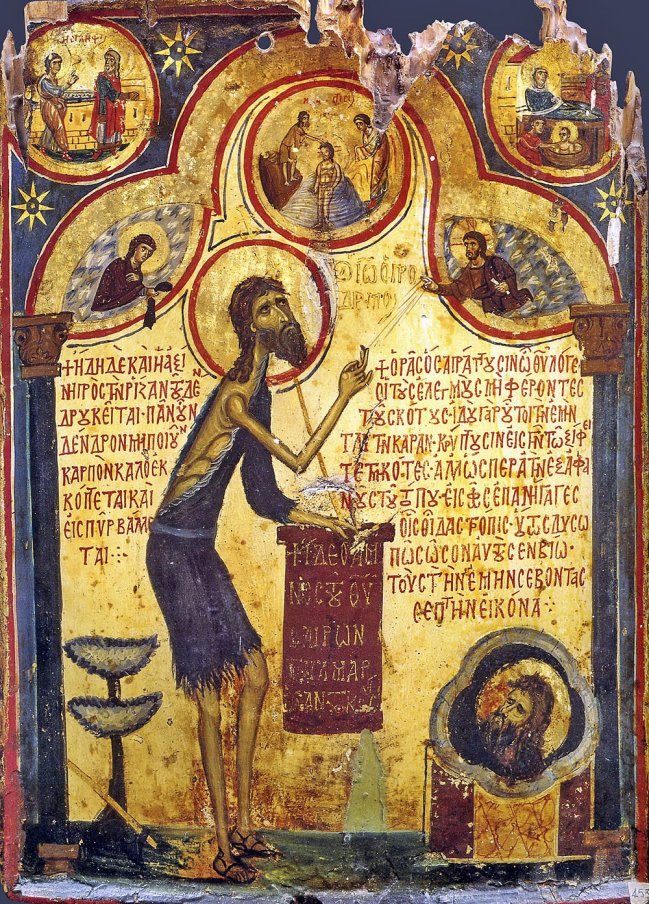
St. John the Baptist has always been very special to me, ever since I converted to Christ and started regularly visiting my spiritual father, a spiritual child and tonsure of St. Paisios, at the Monastery of St. John the Forerunner (Prodromos).
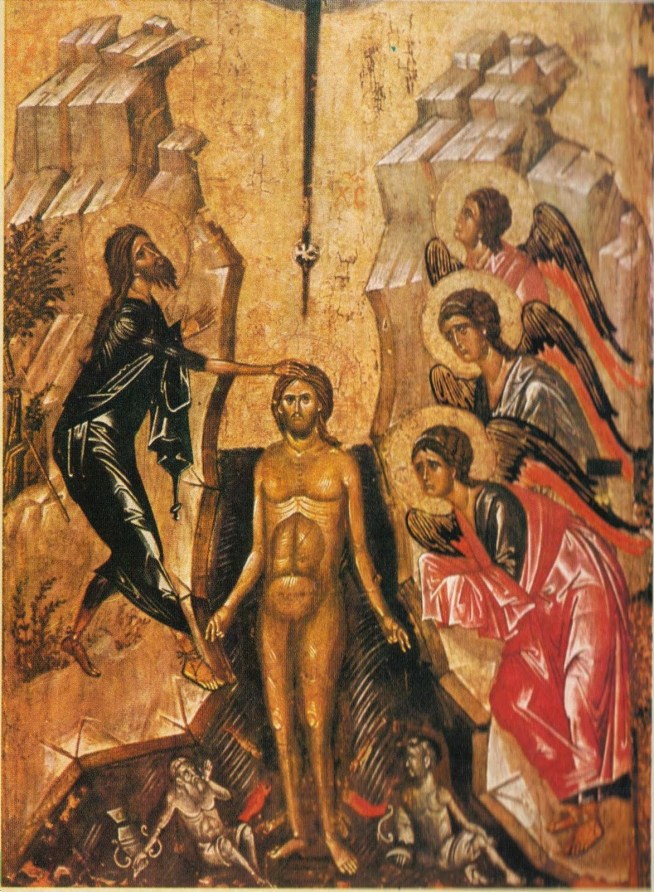
John the Baptist uniquely bore record of both the Dove and the Lamb, la Colombe et l’Agneau. He was the angel-messenger of both the Holy Spirit and the Word, on earth, but also in Hades. He “saw” the Lamb walking in the middle of people in the Person of Jesus. And he testified with an absolute certainty that he “saw” the Holy Spirit descending on Him in bodily form like a dove. (Lev Gillet, La Colombe et L’Agneau, The Dove and the Lamb)
29 The next day John seeth Jesus coming unto him, and saith, Behold the Lamb of God, which taketh away the sin of the world. (John 1:29)
32 And John bare record, saying, I saw the Spirit descending from heaven like a dove, and it abode upon him. (John 1:32)
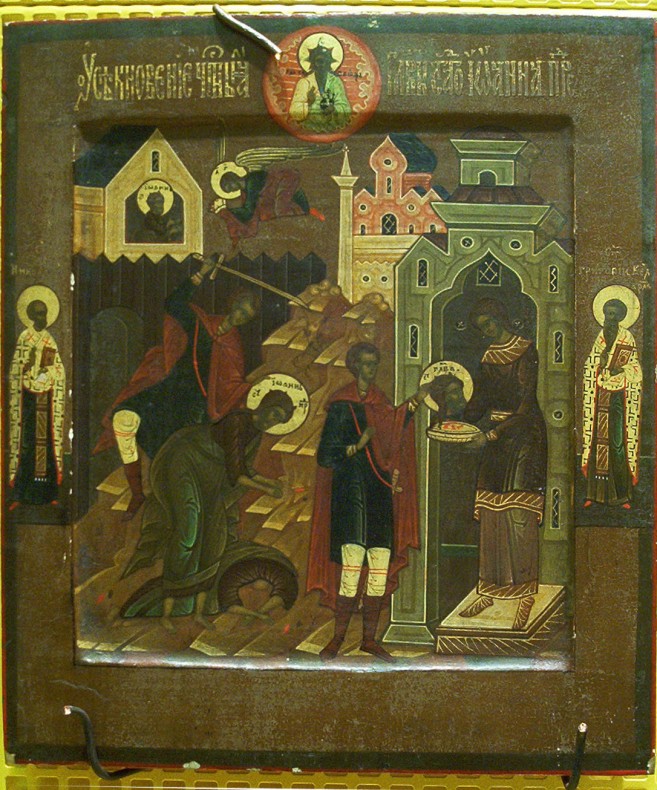
The Holy Prophet, Forerunner, and Baptist John is a towering figure who bridges the Old and New Testaments and who reveals, more precisely than his forebears, the object, the aim, the goal, the purpose of the preceding two-thousand history of the Hebrew people: namely, the advent of the Messiah, the God-man, the Savior, Jesus Christ. That was so since, as Saint Nicholas Velimirović of Ochrid and Zica writes, Saint John “especially differs from all of the other prophets in that he had the privilege of being able, with his hand, to show the world Him about Whom he prophesied.” [Prologue, Vol 1, p. 34. The Prologue of Ohrid: Lives of Saints, Hymns, Reflections and Homilies for Every Day of the Year]

“Moonless”
From your desert, my Saint John
where once your voice was heard
remember us and pity us
who are wasting away in a wilderness
full of human population.
By Alexandros Papadiamantis

The Bridegroom and the Friend of the Bridegroom
“He that has the bride is the bridegroom: but the friend of the bridegroom, who stands and hears him, rejoices greatly because of the bridegroom’s voice: this my joy therefore is fulfilled.” (John 3:29)
Being born exactly half a year before Christ, John the Forerunner by the exact time of his birth depicted his mission of preparing the way for the Lord. He was born at the time of the year (June 24) when the day begins to grow shorter after the summer solstice, whereas the Nativity of Christ occurs (December 25) when the day begins to grow longer after the winter solstice. These facts are an embodiment of the words spoken later, by the Forerunner, after the beginning of Christ’s preaching:
“He must increase, but I must decrease” (John 3:30). “The herald of the Sun, the Forerunner” was John the Baptist, who was like the morning star that announces the rising of the Sun of Righteousness in the East. (Saint John of Shanghai and San Francisco at http://passaicrussianchurch.com/books/english/ sermons_john_maximovich.htm#_Toc100019529)
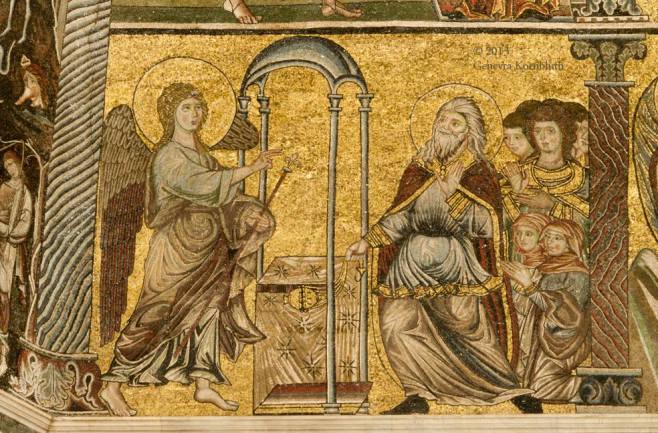

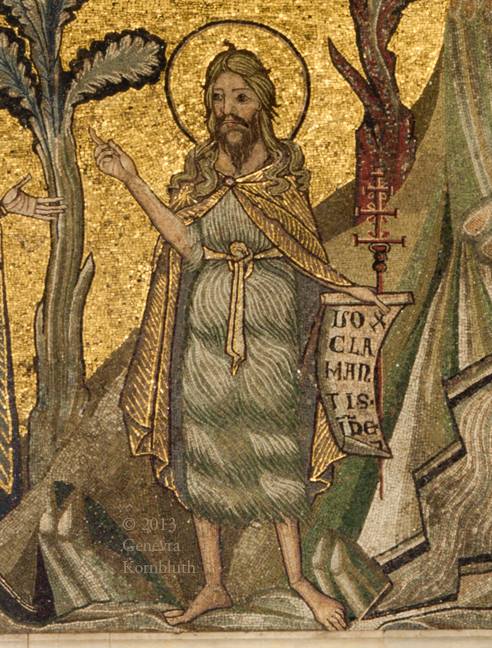
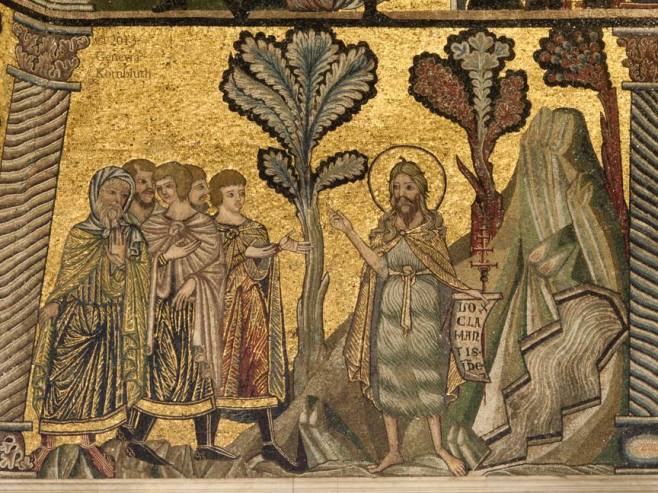




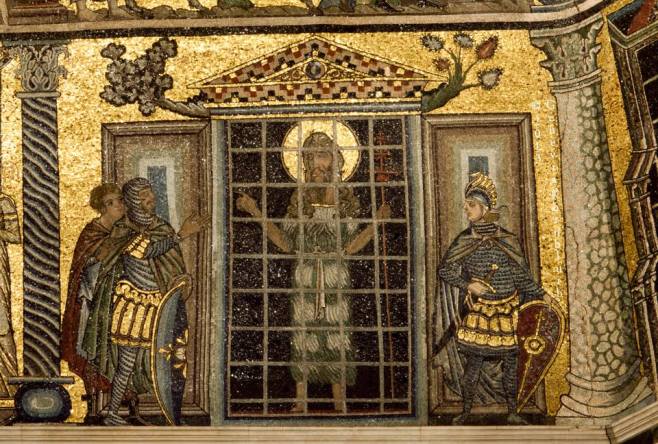
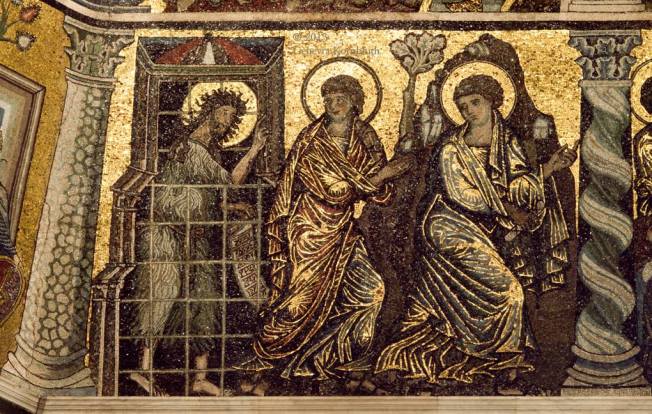



Life of John the Baptist, Baptistery of St. John (Battistero di San Giovanni), Florence
Amazing details above! … Why is this Saint, almost uniquely, shown in many icons with wings? … As well as “the Baptist”, John is also known as “glorious prophet and forerunner of Christ”. Therefore, the presence of the wings is to symbolize John’s status as a divine messenger (in Greek “Evangelos”, from where the word “Angel” is derived). It’s worth noting that the wings of the archangels (Gabriel, Michael etc.) in icons are largely symbolic too, as they are not specifically described as having wings in the Scriptures.
But if that were all, then why aren’t the prophets of the Old Testament, or the Apostles, shown with the angelic wings of divine messenger? The answer, in the words of Jesus Christ Himself, is because “among those born of women there is no one greater than John;” moreover, he is “the culmination and the crown of the prophets”, as the hymn from the feast of John’s nativity proclaims. Therefore, St John is a special example among the Saints of an earthly “angel” and a heavenly man. As such, he is also described as the “Angel of the Desert” in the inscriptions of icons.
The life John led in the desert was angelic for two reasons. On the one hand he proclaimed the coming of the Messiah, Jesus Christ, becoming a herald of God like the angels. On the other, he lived a life of chastity, abstinence, and prayer, not being mindful of material needs, but with his attention fixed firmly to heaven. This is the life of the angels, and why the monastic way of life is sometimes called “angelic”, as well as why St John is the patron of monastics, hermits, and ascetics. For both reasons, it is appropriate to show St John with the spiritual wings of a dove.
She that once was barren now brings forth Christ’s Forerunner, John, the culmination and the crown of all the Prophets. For when he, in River Jordan, laid his hand on Him Whom the Prophets preached aforetime, he was revealed as God the Word’s fore-chosen Prophet, His mighty preacher, and His Forerunner in grace.
(Kontakion from the Feast of the Nativity of John the Baptist)

This is another vita icon, which shows not only John the Forerunner and Baptist, but many of the other feasts and traditions associated with him.
An explanation of the scenes often found in these icons is given below.
The scenes used in the 16th century Yaroslavl icon … are taken from a number of well-established sources: the Protoevangelium of James, the Gospels (notably St Luke’s), and other histories of the Church that record what happened to St John the Baptist’s remains after his beheading. Starting at the top left, and going from left to right across the icon, the scenes shown are:
- The angel Gabriel appears to St Zachariah in the Temple, announcing the future conception of a son: to be called John (Luke 1:11-17).
- Zachariah is struck dumb for doubting the angel’s words, the people outside the Temple realizing he has had a vision of God (Luke 1:18-22)
- The Conception of John the Baptist (Luke 1:23-25)
- The visitation of Elizabeth’s cousin Mary, the Mother of God (Luke 1:39-42)
- The Nativity of John the Baptist
- The murder of St Zachariah in the Temple by Herod’s soldiers, for not revealing where John the Baptist was hidden (Protoevangelium of James Ch.23; alluded to in Luke 11:51)
- St. Elizabeth hides the young John from the Herodian soldiers in the cleft of a mountain (Protoevangelium of James Ch 22, paralleled by Mary and Joseph’s flight into Egypt with Christ; Matthew 2:13-23)
- St. John, as a youth, is led into the desert by an angel, fulfilling the promises given to Zachariah, and Zachariah’s own prophecy (Luke 1:67-80)
- After years of ascetic life, “the word of God comes to John… in the wilderness. (Luke 3:2)
- John baptizes Jesus Christ in the River Jordan
- John baptizes the multitudes who flock to him (Matthew 3:1-6)
- John denounces the Pharisees and Sadducees (Matthew 3:7-10)
- John is imprisoned for his criticism of Herod Antipas (not the same Herod who ordered the murder of Zachariah)
- The Feast of Herod, where Salomne is presented with the head of John the Baptist after beguiling Herod with her dancing.
- The Beheading of John the Baptist (the last three scenes are all recorded in Matthew 14:1-12 and Mark 6:14-29)
- John’s disciples take his body away for burial (usually shown without the head – Matthew 14:12)
- St John the Baptist appears in a dream to monks, telling them where to find his head.
- The First Finding of the Head of John the Baptist
- The appearance of St John to a monk in his sleep.
- The Second Finding of the Head of St John the Baptist
Other scenes that might be present include: Zachariah, mute, writing out the name of John; the denunciation of Herod by John; the preaching of John in Hades (the forerunner of Christ in life and death); In the centre stands John the Forerunner himself: the “angel”, or messenger, of the desert, holding a platter with his head. Other icons may show St John holding a platter with the infant Christ on it, also known as the melismos, or the Lamb of God.

The memory of the just is celebrated with hymns of praise, but the Lord’s testimony is sufficient for you, O Forerunner;
For you have proved to be truly even more venerable than the Prophets, since you were granted to baptize in the running waters Him Whom they proclaimed.
Wherefore, having contested for the truth, you rejoiced to announce the good tidings even to those in Hades:
That God has appeared in the flesh, taking away the sin of the world and granting us great mercy.
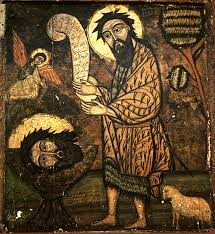
Links:
The Protoevangelium of James
The Beheading of John the Forerunner and Baptist
The Nativity of John the Forerunner and Baptist
The Baptism of Christ (by St John)
The First and Second Finding of the Head of John the Forerunner
The Third Finding of the Head of John the Baptist

This Icon also encompasses all of the Church teaching about St. John the Forerunner: his announcement of the coming of the Messiah, Who was Jesus; his preaching in the wilderness; his baptizing of Jesus Christ, and finally his beheading on the orders of Herod for censuring the King.
… John is depicted … in the desert, wearing animal skins, with unkempt beard and long hair … The axe laying at the foot of a tree is an obvious reference to John’s own prophetic warning recorded in Scripture:
And even now the axe is laid to the root of the trees. therefore every tree which does not bear good fruit is cut down and thrown into the fire.
To the bottom right of the picture, is John’s head on a platter, just as it was presented to Herod’s step-daughter, according to the Gospel of Matthew. It is because of this that John also holds a cross – the cross of martyrdom – and is turned to Christ in supplication, holding a scroll bearing the words:
Seest Thou what suffer those who censure, O Word of God, the faults of the unclean. Not being able to bear censure, Lo Herod cut off my head, O Saviour.
Over St. John’s camel-skin clothing is invariably a green robe, which symbolizes “earthliness”, and in this case it is because John grew up outside, in the wilderness. Later saints who also took up the Christian struggle in the wilderness can also be depicted in green for the same reason, and are sometimes known as “Green Martyrs”. That is to say they are martyrs (literally meaning witness) to the Faith, not by the shedding of blood, but by their ascetic struggle. Of course, St John is a both a green martyr and a martyr who shed his blood, hence the presence of the green robe and the cross.
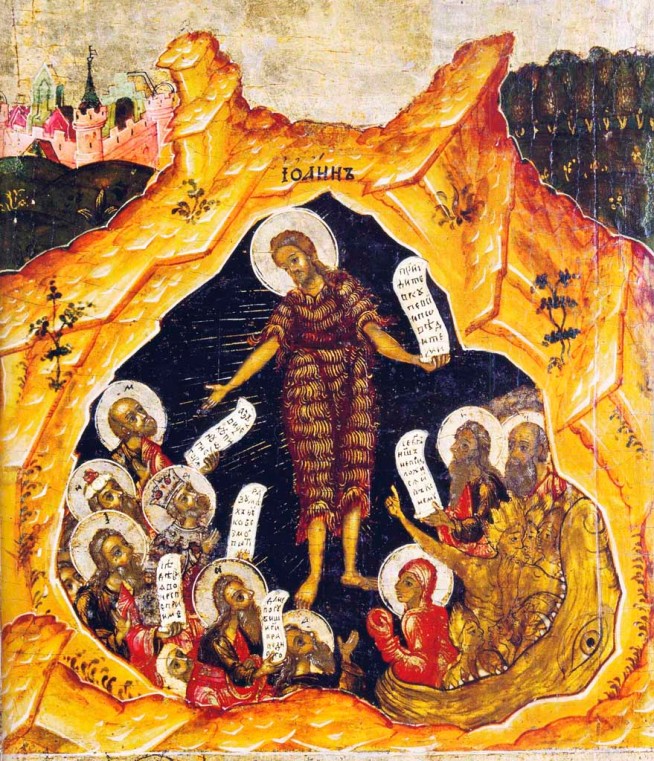
John was the forerunner of Christ on earth, but also in Hades. Before Jesus’ crucifixion, death, burial, and descent into Hades, John too descended there to preach the Gospel of Repentance and coming of the Messiah to the imprisoned souls: The glorious beheading of the Forerunner, became thus an act of divine dispensation, for he preached to those in hell the coming of the Savior. Let Herodias lament, for she entreated lawless murder, loving not the law of God, nor eternal life, but that which is false and temporal.
He Laid His Hand On Him!
Source: iconreader.wordpress.com
![Jesus Prayer].jpg](https://orthodoxcityhermit.com/wp-content/uploads/2016/11/jesus-prayer.jpg?w=648&h=391)



































